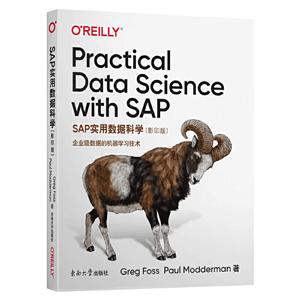SAP实用数据科学
本书特色
[
你是否正在使用SAP ERP系统并迫切希望释放其数据的巨大价值?通过这本实用指导书,SAP资深专家Greg Foss和Paul Modderman为你展示如何使用若干数据分析工具来解决SAP数据中存在的有趣问题。你将跟随一个贯穿全书的虚构公司,学会处理真实场景中遇到的问题。
使用真实数据创建示例代码和可视化图,SAP业务分析师将学会实用的分析方法,从而获得对业务数据的更深入了解。数据工程师和数据科学家将探索如何将SAP数据添加到他们的分析过程中。通过对SAP流程和数据科学工具的深入研究,你将找到揭露数据真相的强大方法。
]
目录
Preface1. IntroductionTelling Better Stories with DataA Quick Look: Data Science for SAP ProfessionalsA Quick Look: SAP Basics for Data ScientistsGetting Data Out of SAPRoles and ResponsibilitiesSummary2. Data Science for SAP ProfessionalsMachine LearningSupervised Machine LearningUnsupervised Machine LearningSemi-Supervised Machine LearningReinforcement Macl’rine LearningNeural NetworksSummary3. SAP for Data ScientistsGetting Started with SAPThe ABAP Data DictionaryTablesStructuresData Elements and DomainsWhere-UsedABAP QuickViewerSE16 ExportOData ServicesCore Data ServicesSummary4. Exploratory Data Analysis with RThe Four Phases of EDAPhase 1: Collecting Our DataImporting with RPhase 2: Cleaning Our DataNull RemovalBinary IndicatorsRemoving Extraneous ColumnsWhitespaceNumbersPhase 3: Analyzing Our DataDataExplorerDiscrete FeaturesContinuous FeaturesPhase 4: Modeling Our DataTensorFlow and KerasTraining and Testing SplitShaping and One-Hot EncodingRecipesPreparing Data for the Neural NetworkResultsSummary5. Anomaly Detection with R and PythonTypes of AnomaliesTools in RAnomalyDetectionAnomalizeGetting the DataSAP ECC SystemSAP NetWeaver GatewaySQL ServerFinding AnomaliesPowerBI and RPowerBI and PythonSummary6. Predictive Analytics in R and PythonPredicting Sales in RStep 1: Identify DataStep 2: Gather DataStep 3: Explore DataStep 4: Model DataStep 5: Evaluate ModelPredicting Sales in PythonStep 1: Identify DataStep 2: Gather DataStep 3: Explore DataStep 4: Model DataStep 5: Evaluate ModelSummary7. Clustering and Segmentation in RUnderstanding Clustering and SegmentationRFMPareto Principlek-Meansk-MedoidHierarchical ClusteringTime-Series ClusteringStep 1: Collecting the DataStep 2: Cleaning the DataStep 3: Analyzing the DataRevisiting the Pareto PrincipleFinding Optimal Clustersk-Means Clusteringk-Medoid ClusteringHierarchical ClusteringManual RFMStep 4: Report the FindingsR Markdown CodeR Markdown KnitSummary8. Association Rule MiningUnderstanding Association Rule MiningSupportConfidenceLiftApriori AlgorithmOperationalization OverviewCollecting the DataCleaning the DataAnalyzing the DataFioriSummary9. Natural Language Processing with the Google Cloud Natural Language APIUnderstanding Natural Language ProcessingSentiment AnalysisTranslationPreparing the Cloud APICollecting the DataAnalyzing the DataSummary10. ConclusionOriginal MissionRecapChapter 1: IntroductionChapter 2: Data Science for SAP ProfessionalsChapter 3: SAP for Data ScientistsChapter 4: Exploratory Data AnalysisChapter 5: Anomaly Detection with R and PythonChapter 6: Prediction with RChapter 7: Clustering and Segmentation in RChapter 8: Association Rule MiningChapter 9: Natural Language Processing with the Google Cloud NaturalLanguage APITips and RecommendationsBe CreativeBe PracticalEnjoy the RideStay in TouchIndex
封面

书名:SAP实用数据科学
作者:Greg Foss,Paul Modde
页数:12,316页
定价:¥99.0
出版社:东南大学出版社
出版日期:2020-06-01
ISBN:9787564188818
PDF电子书大小:136MB 高清扫描完整版
